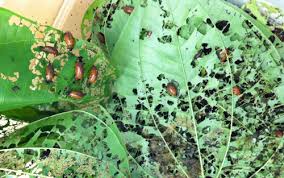Could a tiny bug known as Pseudophilothrips ichini change Florida’s landscape for the better?
Introduced last month in Broward County, the insects – more commonly known as thrips – eat the growing tips of the invasive Brazilian pepper trees.

They stunt the plant’s growth and ability to reproduce. Over time, they prevent the spread and slow the growth of the tree that now dominates up to 700,000 acres in Florida.
There are no immediate plans to release the thrips near Tampa Bay, where Brazilian pepper trees grow in both inland and coastal areas including parks and preserves where they thrive on salty, brackish and even fresh water.
“We’ve been working with the thrips in the lab for nearly five years, but we’re not sure how they’re going to do in the wild,” said Carey Minteer, the University of Florida professor who led the research team that identified the thrips and then documented its safety and efficacy.

The thrips are “super easy” to raise in laboratory settings so Minteer is hopeful that they’ll be available across the state soon.
“We’re getting hundreds of emails from people who want to distribute them on both public and private lands,” she said. “The key is balancing the resource – learning how many we need to release to establish a population in the wild. We’re looking for that ‘sweet spot’ that we need to see in the field and not in a lab.”
The initial release was 100 vials of 10 thrips each in a pepper-infested park in Broward County, she adds. Researchers will monitor their impact for at least a year.
The Release is End of Long Road

Reaching the point of actually releasing the thrips has been a long road, beginning with researchers looking at what kinds of insects helped control Brazilian pepper trees in their native country. Once insects that cause the most damage were identified, they were brought back to Florida for testing in Minteer’s quarantined Fort Pierce lab.
“It takes a very long time to go through the system to make sure we’re not releasing an insect that could harm native plants or those with commercial value,” she said. “We’ve literally tested them against hundreds of other types of plants to make sure they’re safe to release.” First were native plants like poison ivy and sumac, which are closely related to pepper trees, then came mangoes and pistachios which are “cousins.” Finally, they were tested against economically valuable plants like citrus and cotton.
“Some pests will attack nearly any plant, so we needed to make sure that these thrips weren’t going to eat anything but Brazilian pepper trees. We literally gave them a choice of eating another plant or starving to death – they passed the test when they starved.”
And only an entomologist would happily describe what thrips do to Brazilian pepper tree: “The growing tip turns a really nice dark brown and dies,” she says.
Building on Success
 The thrips are actually the second success story from Minteer’s lab, which was also involved in the research that led to the release of the air potato beetle in 2001.
The thrips are actually the second success story from Minteer’s lab, which was also involved in the research that led to the release of the air potato beetle in 2001.
Some gardeners were skeptical about its ability to control invasive and non-edible air potatoes – but not limit the growth of tropical edibles like yams.
“We haven’t experienced a problem yet, but there is still plenty of their primary forage up there,” said “Jungle Jay” Hardman, a certified permaculture designer in St. Petersburg who specializes in food crops that survive Florida summers.
“What happens with the beetles is that they become part of a cycle,” Minteer said. “They reproduce quickly when they have plenty of food, but then their growth slows down as their food source is limited. When the plants start to grow again, so do populations of air potato beetles.”
The beetles are available at no charge June through November when the air potatoes are actively growing. Click here to request a shipment.
Biological controls released from another UF lab are currently at work on melaleuca, with significant success but not 100% control.
The melaleuca weevil, released in 1997, has been successful in establishing itself in some areas, although they require dry soil for larvae to grow. Since melaleuca usually grows in standing water, the weevils can’t survive in areas like the Everglades.

In other areas, however, the melaleuca psyllid, Boreioglycaspis melaleucae has become so well established that they are killing small saplings. The psyllids also reduce flowering and seed production and stunt the growth of older trees by sucking out the plant juices. Psyllids, also known as plant lice, are generally plant specific and feed on a single plant species, or closely related plants.
Love Bugs Never Released as a Biocontrol
One of the consistent issues raised as scientists release insects for biocontrol of weeds is the prevalence of love bugs, which urban legends say were unleashed by UF to eat mosquitoes. “Totally not true,” says Minteer. Love bugs, which are also found in Mexico and Texas, only feed upon nectar and their larvae survive on decomposing soil.
“They naturally migrated to Florida – no one ever released them intentionally,” Minteer said.
Enjoy this article? Check out more articles on invasives species in our region.
[su_divider]
